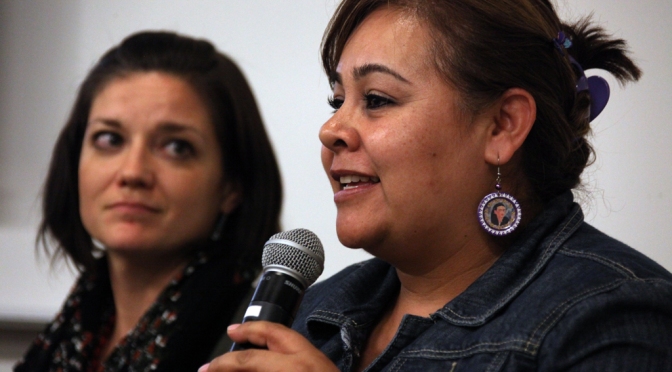The opening night of the Global Women’s Rights Forum on Monday, March 5 gathered a crowded room of students and staff at a panel discussion about economic inequality and the Occupy movement.
USF professor Dorothy Kidd addressed the unifying theme of women’s rights and economic struggles at the event saying, “The austerity strategies that we’re being faced with have a specific resonance for women.” Kidd said the Occupy movement in the fall of 2011 was one of the most creative and imaginative forms of protest she’s ever seen and she added that it “strings across the world” political, social, and economic issues.
As usual, the 11th forum hosted by an organizing committee of faculty, staff and students from various departments, coincided with International Women’s Day celebrated on March 8.
Yet professor Cecilia Santos of the Sociology Department, one of the event’s main organizers, said the forum’s format has evolved since its founding.
“In 2002 we organized a series of lectures and movies to celebrate International Women’s Day and to honor the work and life of Ester Madriz, a Sociology professor, who passed away in early 2002. The event was so successful that we decided to do it again the next year.”
Since then the event has continued under the headline “Global Women’s Rights Forum”, and has included lectures on various topics from Asian immigrant lesbians to gender based violence in the criminal justice system.
This year the event had a noticeably current-events centered theme, with two of the evening’s talks titled “Transnational Feminisms and Women Movements/ Uprisings/ Revolutions” and the aforementioned “Economic Justice and the Occupy Movement.”
Tying the importance of the week’s topics to the role of women, USF Academic Vice President and Provost Jennifer Turpin highlighted statistics pertaining to USF’s role in women’s rights. Turpin said USF had its first female faculty member in 1947, and currently has an almost 50% female faculty of which 27% are women of color.
Santos said those numbers are taken into considerations by the forum’s organizers.
“The committee has always been inter-disciplinary, and has included faculty from diverse ethnic backgrounds,” she said.
The panelists vary as well, with this year’s speakers including five professors (only one from USF), a reverend, a dancer, three representatives of community advocacy groups, a police department case manager, and a spoken word artist. Each is considered to bring a unique perspective to the table, and represent the mission of the forum to “assist in unpacking intersected systems of oppression and privilege based on differences.”
Santos said this year was also the first year the organizing committee included students as part of its planning. This may have played a role in the large attendance at events which had students lining the walls and sitting on the floor. This year’s focus on current events and the role of women in popular uprisings gathered nearly 300 people throughout the forum’s four nights. Santos said she feels the forum has always been popular among students, but that in recent years professors have made an effort to link the forum’s topics to their classes, which has contributed to a larger turnout.
In its eleventh year, the Global Women’s Rights Forum continues to reinvent ways to analyze women’s role in global issues, continuing its goal “to promote an exchange of knowledge and a cross-cultural dialogue between scholars, activists, artists, the USF community and the larger community in the Bay Area.”

